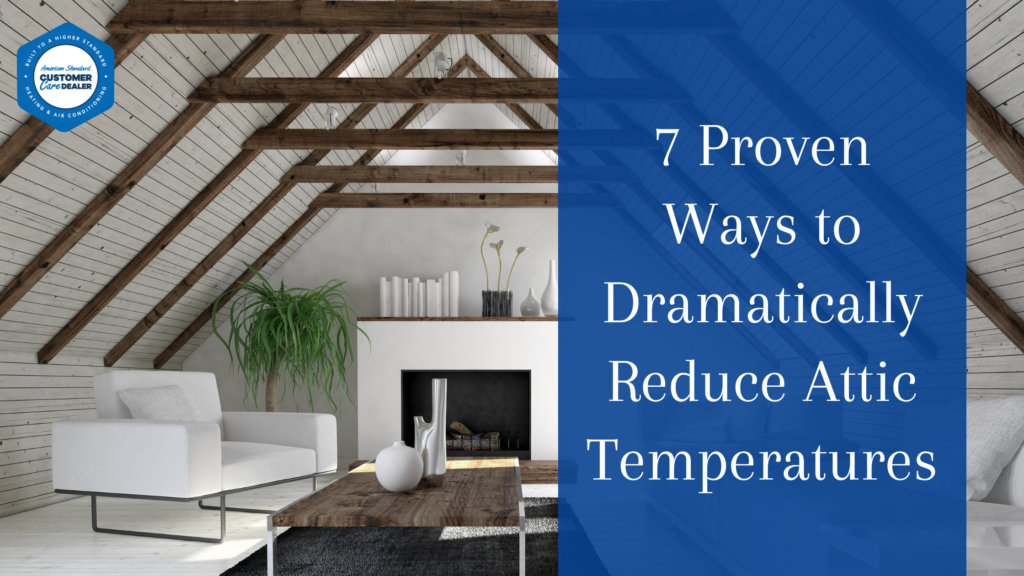7 Proven Ways to Dramatically Reduce Attic Temperatures
Your attic might be silently working against you during the sweltering summer months. Attics often trap the heat, pushing temperatures to extreme levels that not only affect the comfort of your home but also run up your energy bills. The hotter your attic, the harder your air conditioning system has to work, meaning higher monthly costs. Thankfully, there are proven ways to cool your attic and keep your home more efficient and comfortable. Here are the top techniques to help you beat the heat this summer.
1. Upgrade Your Insulation
Insulation is your attic’s first line of defense against heat. If your attic isn’t properly insulated, heat can easily pass into your living spaces, making it harder to keep your home cool. Consider upgrading to high-quality materials like spray foam or fiberglass insulation, which provide better thermal resistance. For existing insulation, check for gaps, damage, or areas that need reinforcement. Proper insulation reduces both heat buildup and energy waste by keeping cool air inside and hot air out.
2. Install an Attic Fan
Ventilation is key to reducing attic temperatures. Attic fans work by pulling warm air out of the attic and replacing it with cooler outdoor air. Solar-powered attic fans are an excellent energy-efficient option that can lower cooling costs and reduce your home’s overall carbon footprint. By improving airflow, attic fans can reduce the temperature by 10–25°F, dramatically increasing comfort levels in your home.
3. Seal Air Leaks
Even small gaps in your attic can allow hot air to sneak in or cool air to escape. Inspect your attic for cracks, leaks, or poorly sealed areas around vents, pipes, and light fixtures. Use caulk or weatherproofing materials to seal these gaps effectively. This step not only reduces heat entry but also minimizes your overall energy loss, helping your air conditioning system work more efficiently.
4. Install Reflective Roof Coatings
Reflective or “cool” roofing materials are designed to reflect more sunlight and absorb less heat. Applying a reflective coating or installing materials such as metal, tile, or specially designed asphalt shingles can dramatically reduce the amount of heat entering your attic. These materials can lower your roof’s temperature by up to 50°F on sunny days, making them a smart investment for long-term energy savings.
5. Add Radiant Barriers
Radiant barriers are another cost-effective way to reduce heat gain in your attic. These barriers consist of a reflective material that’s installed on the underside of the roof. They work by blocking and reflecting radiant heat from the sun, keeping it from entering your attic space. When combined with proper ventilation, radiant barriers can significantly lower attic and home temperatures.
6. Enhance Attic Ventilation
Proper ventilation is a game changer when it comes to controlling attic temperatures. Ridge vents, soffit vents, and gable vents allow hot air to escape naturally and prevent heat buildup. Ensure your attic has a balanced system of intake and exhaust vents to promote consistent airflow. Even small changes to your home’s ventilation system can lead to noticeable improvements in energy efficiency.
7. Invest in a Cool Roof System
If you’re looking for a more comprehensive solution, consider upgrading to a cool roof system. Cool roofs are specially designed to reflect more sunlight and absorb less heat than a standard roof. They’re often made with highly reflective paints, tiles, or shingles. While the upfront cost is higher, cool roofs can significantly reduce attic temperatures and air conditioning costs in the long run.
Benefits of Cooling Your Attic
By reducing your attic’s temperature, you’ll enjoy several benefits. These include lower utility bills, a more comfortable home, an HVAC system that lasts longer, and a reduced environmental impact. Plus, keeping your attic cooler can also help protect stored items from heat damage.
Frequently Asked Questions
Q1. Why is my attic so hot during summer, and how does it affect my home?
Your attic collects and retains heat from the sun, often making temperatures soar above 130°F. This heat can seep into living areas, increasing cooling costs and reducing indoor comfort. A hot attic also strains your HVAC system and can cause it to wear out prematurely.
Q2. How much can attic ventilation reduce heat?
Proper attic ventilation can lower attic temperatures by 10–25°F, depending on your home’s layout and the ventilation system used. When paired with insulation and radiant barriers, the benefit can be even greater.
Q3. Are solar-powered attic fans worth the investment?
Yes. Solar-powered attic fans reduce your reliance on electricity while cooling the attic. They save energy, help extend the life of your roof, and improve your home’s comfort without increasing your utility bills.
Q4. What is a radiant barrier, and does it really work?
Radiant barriers are reflective materials installed in attics to block radiant heat from the sun. They’re highly effective in keeping homes cooler, especially in hot climates, by preventing up to 97% of radiant heat from entering.
Q5. Does improving attic insulation help in winter too?
Absolutely! Proper insulation keeps your home warm during the winter by preventing heat loss, reducing energy consumption, and ensuring year-round comfort.
Contact Us
Spencer Heating and Air is here to help you maintain a cool and energy-efficient home this summer! Ensure your home stays comfortable, efficient, and cost-effective by reaching out to us for all your HVAC and home cooling needs. Spencer Heating and Air is a trusted American Standard Heating & Air Conditioning Customer Care Dealer in Auburn, AL. For more tips and updates, follow us on Facebook and Instagram. reduce attic temperature reduce attic temperatures reduce attic temperature reduce attic temperatures


